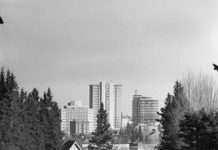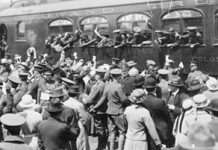It was a typical Sunday 70 years ago, November 7, 1948. The suburban quiet occasionally interrupted by the familiar squeak and rattle of the South Calgary streetcar. By Monday morning’s rush hour (such as it was back then), a diesel bus was temporarily on the route. A trolley bus (that’s an electric bus powered by overhead wires) took over in February and ran until the early 1970s.
Since 1913, the No. 7 streetcar had travelled in a loop around South Calgary; it came up 14 Street to 26 Avenue, travelled west to 20 Street, rolled down the hill to the corner of 34 Avenue, turned east, and then went back down 14 Street to the center of town. The route was part of an extensive streetcar network developed in the early 20th century boom to connect the center of town to far-flung industrial areas and new “streetcar suburbs” like South Calgary.
By the late 1940s Calgary was on the cusp of another boom, following the end of World War II and the big oil strike in Leduc in 1947. Most of Calgary’s streetcars were still the originals, and all of them were replaced by buses by 1950. The new No. 7 bus went down 33 Avenue, instead of 34 Avenue, and for many years turned around at a loop not far past the Marda Theatre, which opened in 1951 at the corner of 20 Street (where Global Pet Foods is now).
Marda Loop takes its name from that theatre, and these two loops – the old streetcar loop around South Calgary, and the later trolley bus loop on 33 Avenue. And the No. 7 route designation has never changed. The streetcar’s legacy lives on!
For more on commemorating the old Marda Loop streetcar’s last run, check out www.visitmardaloop.com and follow @visitmardaloop on social media.









